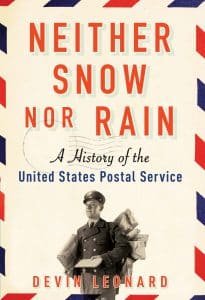The Postal Service is Efficient … Really
The U.S. Postal Service was established in its present form in 1971 but traces its history to 1775. That’s when Benjamin Franklin, who became the first postmaster general, developed an early iteration of the system we know today.
Based on Franklin’s model, the post office department was founded in 1792 — a system of mail delivery that has proved capable of responding to great changes in the way Americans communicate. That flexibility has made what became USPS a remarkably durable institution of government. In Neither Snow Nor Rain: A History of the United States Postal Service, Devin Leonard of Bloomberg Businessweek seeks to understand how the Postal Service has responded to these changes and what its survival can tell us about all government institutions.
The Postal Service has a reputation as a kind of joke, and is sometimes seen as a model of government inefficiency. But you say this is misleading.
The Postal Service delivers 513 million pieces of mail per week, so it is highly efficient. It has also proven to be really good at responding to changes in the culture and in meeting the needs of the country.
In what way?
In its earliest days, Franklin saw a national system for delivering the mail as one way of uniting the colonies and of exchanging information and ideas. George Washington believed in making sure it was possible to deliver mail to the hinterlands because he was concerned for the survival of this baby nation. Settlers lived in parts of what is now the United States where the Spanish, French and British had claims, and Washington didn’t want these settlers declaring allegiance to one of these other nations. He wanted to extend the influence of the federal government, and he wanted to make it affordable to send newspapers to the hinterlands. He saw all this as encouraging the new nation’s economic development.
 But over time, the postmaster general began to play a political role, right?
But over time, the postmaster general began to play a political role, right?
For decades, the responsibility of the postmaster general was to reward the faithful and punish political enemies. The postmaster general was often the successful presidential candidate’s campaign manager. The postmaster general was a presidential appointee, and the postmaster general was in charge of patronage. This goes all the way back to Andrew Jackson’s day. It remained the case until 1970.
What happened then?
In 1966, there was a Christmas season logjam at the Chicago post office, leading to a total shutdown in operations. Four years later, there was a strike by federal postal workers that started in New York and spread, and President Nixon called out the armed forces to move the mail. This focused attention on the Postal Service, and Congress decided the postmaster general had too much power and created a nonpartisan federal agency. Today, the postal worker unions have more power than the postmaster general.
Today, with so much communication taking place on our mobile devices and laptops, the Postal Service must be struggling.
Writing and sending letters has been declining since the beginning of the past decade. The Postal Service makes its money through single-piece stamped mail, but mail of that kind has declined about 50 percent over the past 10 years. Most of the mail we receive — catalogues, for example — isn’t stamped but metered mail. It’s what people call “junk mail,” a term the Postal Service despises. So financially, yes, the Postal Service is at one of those inflection points where it has to change to survive. But as I’ve said, this is a governmental institution that has proven very flexible.
Can you give an example of that flexibility?
Back in 2013, Amazon was growing so fast it couldn’t deliver all of its packages, so the Postal Service entered into a deal with Amazon to deliver some of those packages. This allows the Postal Service to generate revenue on Sunday when it is otherwise idle. But Amazon has grown, has more of its own trucks and has entered into other agreements with local delivery firms. So once again, the Postal Service has to adjust, and it probably will.
A lot of cynics probably doubt that.
That’s true, but that’s because the Postal Service has done such a poor job of branding itself and communicating its value. As I said, it is highly efficient — the most efficient system of its kind in the world. For a government agency, it is also remarkably adaptive. It has survived for three centuries because it has been able to re-invent itself.
Reach Leonard at [email protected] or 212.617.1642.



